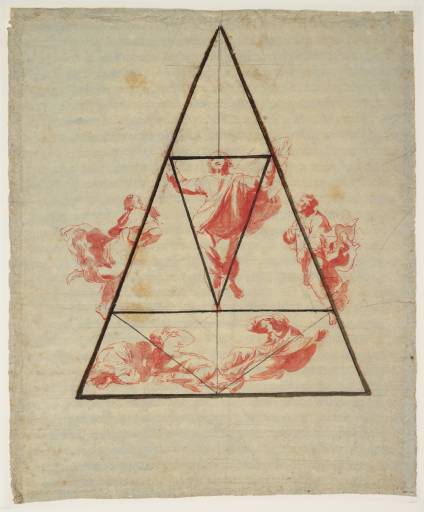Joseph Mallord William Turner Lecture Diagram 10: Proportion and Design of Part of Raphael's 'Transfiguration' c.1810
Joseph Mallord William Turner,
Lecture Diagram 10: Proportion and Design of Part of Raphael's 'Transfiguration'
c.1810
Joseph Mallord William Turner 1775–1851
Lecture Diagram 10: Proportion and Design of Part of Raphael’s ‘Transfiguration’ circa 1810
D17134
Turner Bequest CXCV 163
Turner Bequest CXCV 163
Pencil and watercolour on white laid paper 617 x 507 mm
Accepted by the nation as part of the Turner Bequest 1856
Exhibition history
1980
‘JMWT PP’: A Selection of Drawings Made by Turner to Illustrate his Royal Academy Lectures as Professor of Perspective, Tate Gallery, London, July 1980–January 1981 (2).
1992
Turner as Professor: The Artist and Linear Perspective, Tate Gallery, London, October 1992–January 1993 (23, reproduced).
2004
Vanishing Point: The Perspective Diagrams of J.M.W. Turner, Tate Britain, London, May–November 2004 (no number, reproduced in colour).
2007
Turner Hugo Moreau: Entdeckung der Abstraktion, Schirn Kunsthalle, Frankfurt, October 2007–January 2008 (64).
References
1909
A.J. Finberg, A Complete Inventory of the Drawings of the Turner Bequest, London 1909, vol.I, p.595, CXCV 163, as ‘Group from Raphael’s “Transfiguration,” intersected to show pyramidal form of composition’.
1980
Judy Egerton [and Clifford Ellis], ‘JMWT PP’: A Selection of Drawings Made by Turner to Illustrate his Royal Academy Lectures as Professor of Perspective, exhibition catalogue, Tate Gallery, London 1980, p.[5].
1983
Barry Venning, ‘Turner’s Annotated Books: Opie’s “Lectures on Painting” and Shee’s “Elements of Art” (II)’, Turner Studies, vol.2, no.2, Winter 1983, p.47 reproduced.
1987
John Gage, J.M.W. Turner ‘A Wonderful Range of Mind’, New Haven and London 1987, p.142 reproduced pl.209.
1987
Andrew Wilton, Turner in his Time, London 1987, p.99 reproduced pl.134.
1992
Maurice Davies, Turner as Professor: The Artist and Linear Perspective, exhibition catalogue, Tate Gallery, London 1992, pp.31, 36, reproduced fig.23.
1994
Maurice Davies, ‘J.M.W. Turner’s Approach to Perspective in His Royal Academy Lectures of 1811’, unpublished Ph.D thesis, Courtauld Institute of Art, London 1994, pp.252, 271.
2004
Andrea Fredericksen, Vanishing Point: The Perspective Diagrams of J.M.W. Turner, exhibition catalogue, Tate Britain, London 2004, pp.33, 34 reproduced in colour pl.21.
2007
Max Hollein and Raphael Rosenberg, Turner Hugo Moreau: Entdeckung der Abstraktion, exhibition catalogue, Schirn Kunsthalle, Frankfurt 2007, pp.120–1 reproduced in colour.
The Transfiguration by Raphael (Pinacoteca Vaticana, Rome) was seen by Turner in the Louvre, Paris, in 1802; a probable colour key of it is in his Studies in the Louvre sketchbook (Tate D04287; Turner Bequest LXXII 13). This diagrammatic treatment must have been based on engraved sources as no other drawing by Turner made directly from the picture is known.
At the conclusion of the version of Lecture 1 delivered on 7 January 1811, as Professor of Perspective at the Royal Academy, Turner returns to the role of geometry in the history of painting.1 His diagram of The Transfiguration demonstrates how the upper part of the composition is made up of intersecting triangles, forming a pyramid, and shows how the figure of Christ is larger than the others because it is nearer to the viewer. Turner claims that it would be presumptuous on his part to say whether Raphael ‘had any allegorical intention in placing the three figures at the top of the picture,’ only that it was clear from the design the extent to which he followed geometric rules. As he puts it, ‘the higher the authority the stronger may it be affirmed that lines cooperate and that chance could not have produced the positive geometric figure in the “Transfiguration” which is now placed before us’. There are three sketches related to this diagram in the preliminary draft of the lecture.2 Turner’s varied critiques and treatments of the Transfiguration in other lecture material are noted by Barry Venning.3
For another diagram numbered ‘10’, of an architectural elevation, see Tate D17144; Turner Bequest CXCV 173. That the present one was used in 1811 is confirmed by press reports. On 8 January The Sun recorded Turner showing ‘a print of Raphael’s “Transfiguration”’ together with his ‘geometrical diagram on the subject’4 and The Examiner described how he ‘inculcated the advantage of geometry in painting from the practice of Raphael, especially in his celebrated work of the Transfiguration, in which the figures of Christ and others are geometrical agreeably to the recommendation of Michael Angelo to make the figure three by two’.5
Verso:
The diagram is now separated from its original backing (Tate D40001) which is inscribed in red watercolour ‘10’ at the bottom left corner.
Andrea Fredericksen
June 2004
Supported by The Samuel H. Kress Foundation
Revised by David Blayney Brown
January 2012
How to cite
Andrea Fredericksen, ‘Lecture Diagram 10: Proportion and Design of Part of Raphael’s ‘Transfiguration’ c.1810 by Joseph Mallord William Turner’, catalogue entry, June 2004, revised by David Blayney Brown, January 2012, in David Blayney Brown (ed.), J.M.W. Turner: Sketchbooks, Drawings and Watercolours, Tate Research Publication, December 2012, https://www

